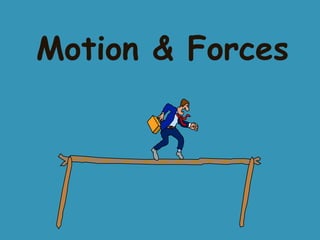
Force new
- 2. Speed & Velocity • Speed - the rate of change in position over time (distance/time) • Instantaneous speed • Average speed • How is velocity different from speed? Velocity describes both speed and direction
- 3. Change in Velocity What makes an object change velocity?
- 4. Force • Push or Pull • Forces can cause a change in velocity • Examples: Gravity Magnetism Friction
- 5. Balanced Forces Forces that – act on the same object – are opposite in direction – are equal in size
- 6. Balanced Forces Book on table 1. Weight of the book is downward force caused by gravity 2. Table pushes back with an equal and opposite force Net force is zero
- 7. Unbalanced Forces Forces that are NOT opposite and equal What do they cause? CHANGE IN VELOCITY ACCELERATION
- 8. Friction Force that opposes motion between 2 surfaces Depends on the: •types of surfaces •force between the surfaces
- 9. Types of Friction • Static Friction: (Couch Potato) –Force between objects at rest • Sliding Friction: (Ice skating) –Solid surfaces slide over each other • Rolling Friction: (Rollerblading) –An object rolls over a surface. • Fluid friction: (Submarine) –An object moves through a fluid
- 10. Friction Friction is greater... –between rough surfaces –when there’s greater force between surfaces (such as more weight)
- 11. Lubricant Changes sliding friction into fluid friction
- 12. Friction Is friction always bad?
- 13. Gravity The attractive force between all objects in the universe
- 14. Acceleration of Gravity Near the surface of the earth the acceleration due to gravity is 9.8 m/s/s
- 15. Newton’s 1st Law An object at rest remains at rest and an object in motion will continue moving at a constant velocity unless acted on by unbalanced forces.
- 17. Newton’s 1st Law INERTIA • tendency of an object to resist any change in its motion • increases as mass increases
- 18. Newton‘s 2nd Law If more force is applied, an object will be accelerated _____more
- 19. Newton’s 2nd Law • More force means more acceleration • More mass means less acceleration Force = mass X acceleration F = ma
- 20. Newton’s 3rd Law For every action, there is an equal and opposite reaction. Forces occur only in pairs – Act on different objects – Equal and opposite
- 21. Newton’s 3rd Law The hammer exerts a force on the nail to the right. The nail exerts an equal but opposite force on the hammer to the left.
- 22. Momentum
- 23. Terminal Velocity The final speed of a falling object.
- 24. Terminal Velocity Air resistance is offsetting the the weight of the object
- 26. Forces End
- 27. Force Aristotle's idea: For an object to move at a constant speed, a constant force must be applied.
- 28. Force Newton’s idea: An object moving at a constant speed will continue at that speed without additional force being applied.
- 29. Balanced Forces